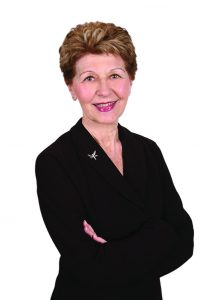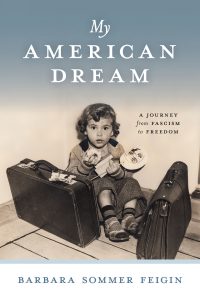Thoughts on My Process as a Writer
Thoughts on My Process as a Writer

Barbara
I’m Barbara Sommer Feigin, a refugee who at age two-and-a-half escaped from Nazi Germany in July of 1940, at the onset of World War II with my Jewish father, my Lutheran mother and 79 other refugees on a terrifying seventeen-day train trip from Berlin to Yokohama, Japan, and from there across the Pacific to Seattle.
I grew up in Chehalis, a tiny town in southwest Washington State, yearning to become an “authentic” American girl. I graduated from Whitman College before completing a graduate program in business administration run jointly by the Harvard Business School and Radcliffe Graduate School. I went on to shatter some glass ceilings as I found success in a male-dominated business—advertising, in an era when career-building opportunities for women were virtually non-existent.
During my thirty-year career as a senior executive at Grey Advertising (now Grey Global Group) and my years as a corporate director, I was more often than not the only woman in the room. My husband, Jim, and I built a strong, loving family of three sons, including identical twins. Our world came crashing down when Jim had two very serious strokes when he was quite young. For the next twenty-five years, I was his care-giver-in-chief. I currently live in New York City.
I’d known, of course, that we’d escaped from Nazi Germany, but I knew nothing about the escape itself—none of the horrifying details. My parents never spoke of it, and I remembered nothing. So, I was totally shocked—stunned, when one day when I was in my 70’s, my sister called me to tell me she had found among my late father’s papers a journal he’d kept, chronicling our family’s escape. Reading the journal was emotionally overwhelming for me. I learned so much about my parents—their hopes and dreams, their worries and concerns, and their great strength of character that I’d never known or even thought about. The journal filled a gaping hole in my own family history.
It helped me to understand more completely what made me who I am. This was the impetus for me to write my own story. I wanted my children, their children, and generations to come never to be as ignorant of what came before them as I had been. Beyond that, I hoped to inspire others to dream big, work hard, and never quit.
While I knew after reading my father’s journal that I needed to write my own story, I had no idea how to start. I got some advice from a cousin of my husband, acclaimed author, Susan Rieger. She suggested I get a coach, and within several months I started working with Keith Meatto, a teacher of creative writing Keith and I worked together doing three-hour transcribed interviews once a week for three months along with homework assignments in what Keith termed the “generative phase” of my project.
In addition to my work with Keith, I did many interviews/conversations with people from every phase of my life: my sister and others in my family, high school and college classmates, colleagues from my business life, and friends. I also visited the town where I’d grown up, touring the house where my family had lived and the elementary, junior high, and high schools I’d attended.
I now had the input for the book, but my next major challenge was how to get started writing it. I was concerned about how to structure my story, since I wanted to include the full text of my father’s journal in his own words and the three intertwined narratives of my own life: a German-speaking refugee girl in a small town, yearning to become an authentic American; a trailblazing executive in a male-dominated business—advertising; and a loving wife and mom who was care-giver-in-chief for her husband after he’d had two serious strokes. With Keith’s help, I developed an initial outline, understanding it might change as the writing process went along, and it did.
Getting started and sticking with it were intimidating. My son, Michael, who has an MFA in creative writing, counseled me nearly daily to stop procrastinating and to write, and my dear friend, Judy Slattery quoted Anne Lamott to me: “Stop not writing. Get and keep [your] butt in chair.” So, writing small pieces at a time with excellent, constructive feedback from Judy at each step of the way, I finally had a manuscript.
I then got excellent help on refining the structure of my story from two developmental editors, Candace Walsh and Gayle Kretchmer. And Gayle, who has an almost musical sensibility, raised my consciousness about the importance of rhythm and lyricism in arranging the words in the story. Once the structure was set, Girl Friday Productions took over the final editing, copy editing, interior and cover design, and remaining pre-production work. Then all materials were turned over to the printer who went to work.
And, at long last, I was thrilled actually to hold my book in my hands! My dream truly had become a reality. My hope is that beyond my family, as others buy and read my book, they’ll not only enjoy it but will be inspired by it. If I can inspire even one person, I’ll feel that I’ve made a difference.
—
Barbara Feigin graduated from Whitman College, earning a Bachelor of Arts degree in political science, and completed a graduate program in business administration run jointly by Harvard Business School and Radcliffe Graduate School.
In her illustrious 30-year career at Grey Advertising (now Grey Global Group), she solidified her reputation as a visionary thinker. In all her years as a senior advertising executive and a corporate director, she was more often than not the only woman in the room. In 2017, Feigin was named one of the century’s Legendary Pioneers by Grey.
Feigin has passed her swagger and hard work ethic on to her three high-achieving sons: Peter, President of the Milwaukee Bucks and FiservForum; Daniel, head of Trevor Day School, a nursery through 12th grade independent school in New York City; and Michael, managing editor at Trellus, an online healthcare start-up.
—
My American Dream: A Journey from Fascism to Freedom (English Edition)
 On August 4, 1940, the Seattle Times featured a photo of a toddler sitting on a dock, surrounded by suitcases and looking dazed. After a harrowing journey with her parents, she’d just stepped off a boat and into her new life in America. Barbara Sommer Feigin was that little girl.
On August 4, 1940, the Seattle Times featured a photo of a toddler sitting on a dock, surrounded by suitcases and looking dazed. After a harrowing journey with her parents, she’d just stepped off a boat and into her new life in America. Barbara Sommer Feigin was that little girl.
Over seventy years later, Feigin made a stunning discovery: her Jewish father had kept a detailed journal that chronicled their family’s escape from Nazi Germany. Her parents had never spoken of it, and she remembered nothing of their terrifying, death-defying passage three-quarters of the way around the world—from Berlin to Seattle by way of Lithuania, Russia, China, Korea, and Japan before crossing the Pacific.
Featuring three intertwining narratives, My American Dream is a memoir of resilience, grit, and grace. Feigin tells of her life as a young German-speaking refugee living in a small Washington town and yearning to become an “authentic” American. She details how she became a trailblazing executive in the advertising business in New York City—a completely male-dominated business in the 1960s—rising from the ranks and ultimately securing a seat in the executive boardroom. A devoted wife and mom of three sons (including one set of twins), she spent twenty-five years as a caregiver for her husband, who suffered two serious strokes, and remained fiercely committed to building strong family bonds during turbulent times.
Despite overwhelming odds, her parents’ grueling journey to America has fueled Feigin’s lifelong resolve to dream big, work hard, and never quit. My American Dream is an inspiring tale of love, dedication, and how uncovering the past and preserving history can inform your identity.
BUY HERE
Category: On Writing






























